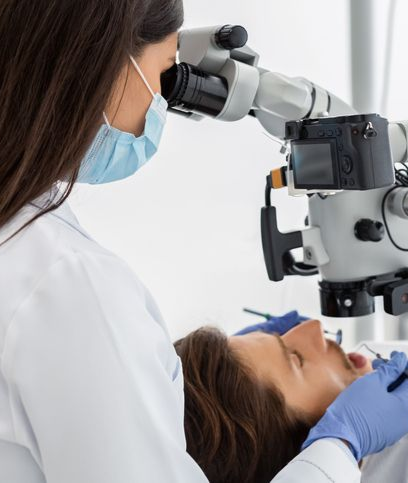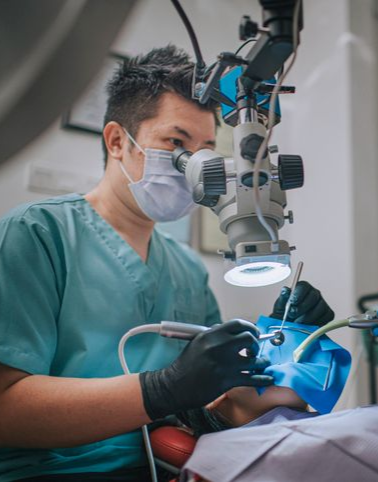Microscopic Endodontics in Coral Springs, FL
What Is Microscopic Endodontics?
Microscopic endodontics is an advanced form of root canal therapy that uses high-powered dental operating microscopes to perform treatment with unmatched accuracy. Traditional endodontics relies on the dentist’s eyes and X-rays, which can sometimes miss tiny canals, fractures, or hidden infection pathways. By magnifying the treatment area up to 25 times, microscopic endodontics allows specialists to see even the smallest details inside the tooth. This leads to more thorough cleaning, precise sealing, and a lower risk of reinfection. Patients benefit from greater comfort, stronger long-term results, and a higher success rate when compared to conventional methods.


When and Why Microscopic Endodontics Is Needed
This procedure is recommended when the pulp (the innermost layer of the tooth that contains nerves and blood vessels) becomes infected, inflamed, or injured. Common situations include:
- Severe tooth pain or lingering sensitivity to hot or cold
- Injury or trauma that damages the pulp, even if no crack is visible
- Swelling, abscesses, or pus near the gums surrounding a tooth
- Discoloration of a tooth, which may indicate dying pulp tissue
- Failed or incomplete root canal treatments that require retreatment
Microscopic endodontics is particularly valuable in complex or challenging cases, such as teeth with narrow, curved canals, hidden anatomy, or recurring infections. The procedure gives dentists the visibility and precision needed to save teeth that might otherwise be considered untreatable. Our experienced dental team will help guide you through the process.
Root Canal Therapy: Another Form of Endodontic Care
While microscopic endodontics represents the most advanced approach, root canal therapy remains the foundation of endodontic care. In a root canal, infected pulp is removed, canals are disinfected, and the space is sealed. This treatment allows patients to keep their natural teeth, restore their bite, and eliminate pain caused by infection.
At Select Dental Care, both root canals and microscopic endodontics are available. The difference is that the microscope adds precision and visibility, making treatment especially beneficial for complex cases or when retreatment is needed. By combining traditional expertise with modern technology, our doctors provide patients with care that is both effective and comfortable.
How Microscopic Endodontics Is Performed: Step by Step
The process for microscopic endodontics is very similar to a traditional root canal, but with far greater precision thanks to the microscope:
This enhanced level of precision ensures that the treatment is thorough, reducing complications and improving long-term success.


What to Do if You Think You Might Need Microscopic Endodontic Care
Recognizing when to seek microscopic endodontic treatment is key to preserving your natural teeth and preventing further complications. By using high-powered dental microscopes, our endodontic specialists at Select Dental Care can diagnose and treat issues with unmatched precision.
Here are signs that may indicate the need for a root canal or other advanced microscopic procedure:
If any of these symptoms occur, seek care promptly. Early intervention with microscopic precision can save your tooth and prevent more complex procedures.
Experience Advanced Endodontics in Coral Springs
At Select Dental Care, our experts, including Dr. Sandra Angel and Dr. Brenda Schobert, offer microscopic endodontic treatment in Coral Springs, FL. By integrating advanced microscope technology into procedures, we ensure precision, comfort, and long-term success—all while delivering compassionate care.
Witness the results of our patient‑first approach in our Smile Gallery.
Ready to protect your smile with the most advanced endodontic care available? Call us today at (954) 752-9065 or
request an appointment online.
Microscopic Endodontics – FAQs
Here are answers to commonly asked questions about root canals and how microscopic technology enhances treatment outcomes:
WHAT IS MICROSCOPIC ENDODONTICS, AND WHY IS IT IMPORTANT?
It uses high-powered dental microscopes to perform root canal therapy with exceptional accuracy, ensuring even the tiniest canals and hidden infections are cleaned and sealed, reducing retreatment risks.
DOES A MICROSCOPIC ROOT CANAL HURT?
No more than a traditional one. Local anesthesia ensures comfort, and microscopic precision helps preserve more of your natural tooth, often leading to a smoother recovery.
HOW LONG DOES MICROSCOPIC ROOT CANAL TREATMENT TAKE?
Typically 60–90 minutes. More complex cases may require additional time or follow-up visits, but the microscope enables efficient and effective cleaning.
WHAT WILL I FEEL LIKE AFTERWARD?
Most patients experience only mild tenderness. Thanks to the precision of microscopic treatment, recovery is often smoother than with conventional methods.
WHAT IF I FEEL PAIN AFTER MY ROOT CANAL?
Some discomfort is normal, but sharp or worsening pain should be addressed promptly. At Select Dental Care, Dr. Angel and Dr. Schobert will re-evaluate the tooth under the microscope to determine if more treatment is needed.
WHAT HAPPENS AFTER MICROSCOPIC ENDODONTIC TREATMENT?
After cleaning and sealing the canals, a crown is typically placed to restore both functionality and appearance, ensuring lasting protection.
CAN A TOOTH GET REINFECTED AFTER A MICROSCOPIC ROOT CANAL?
Reinfection is rare. Microscopic precision significantly reduces the chances of missing a canal or leaving behind infection, making treatment more reliable.
HOW LONG WILL MY TOOTH LAST AFTER MICROSCOPIC TREATMENT?
With proper care, a tooth treated under the microscope can last many years, often a lifetime. Regular checkups are vital for maintaining results.
DOES INSURANCE COVER MICROSCOPIC ROOT CANALS?
Most insurance plans do. Our team will help verify your coverage and explain any out-of-pocket costs. See our Payment Options page for details.
HOW CAN I AVOID NEEDING A ROOT CANAL?
Practice good dental hygiene, attend routine exams, and seek care promptly for injuries. Early detection, especially with microscopic tools, helps prevent problems before they escalate.
ARE THERE ALTERNATIVES TO A ROOT CANAL?
If a tooth cannot be saved, extraction and replacement options, such as implants, are considered. Still, microscopic endodontics aims to preserve your natural teeth whenever possible.


